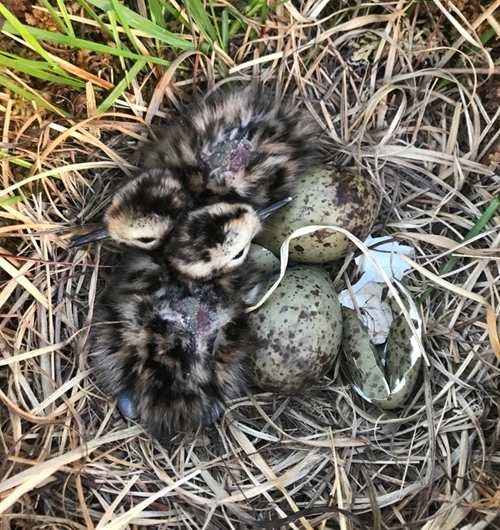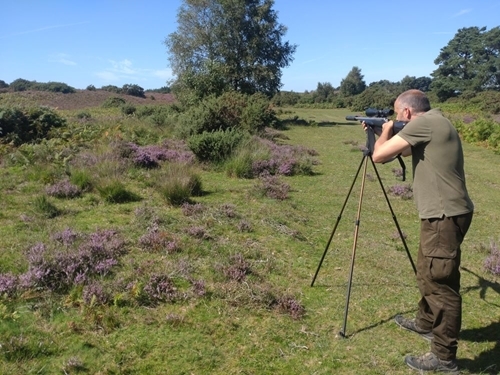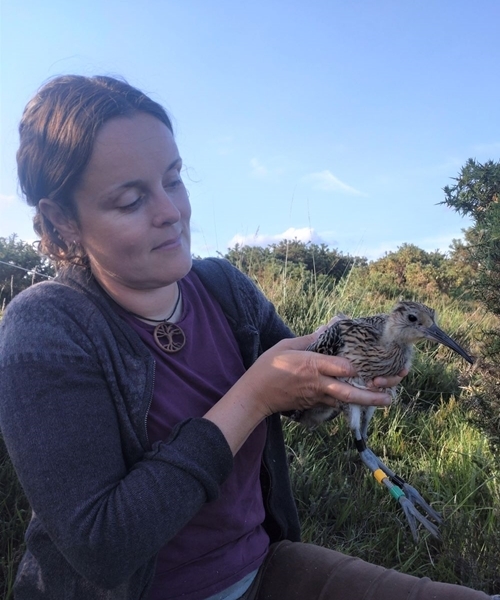By Mike Short, Head of Predation Management Research
The 2023 curlew breeding season has now drawn to a close, and after many years of low productivity in the New Forest, its adult population of curlews – which is likely ageing – has finally produced a reasonable number of fledglings.

The GWCT has worked closely with Forestry England – who are responsible for managing wildlife on the New Forest Crown Lands – since 2020, when Elli Rivers started her New Forest curlew PhD study. After a year of surveying breeding pairs and monitoring nests by repeat visits, it became obvious that poor hatching success was due to extensive predation, and the urgency to understand exactly what problems this rapidly declining population is facing has led to the entire Predation Research team now working to help the New Forest’s curlews.
In 2020, GWCT recorded only 3 curlew chicks as having fledged from 44 known breeding pairs, which equates to just 0.07 fledged chicks/pair. This is way below the 0.5 to 0.6 fledged chicks/pair threshold which is required to maintain a stable breeding population. It points towards either poor nest or chick survival, but more likely both, as the major demographic constriction affecting curlews in the New Forest.
In 2021 and 2022, nest monitoring with cameras showed unequivocally that fox predation was the principal cause of curlew nest failure. This critical knowledge, coupled with strategic guidance on how to deal with the problem, immediately steered Forestry England towards a scientific-based program of predation management with a focus on seasonal culling of foxes and crows in areas where waders breed.
Improving nest survival is one thing, but improving chick survival is another: it’s much harder to achieve, because unlike a static clutch of eggs which can be protected by a variety of ways, curlew chicks are highly mobile, which also makes chick survival research challenging.
Chicks remain vulnerable to foxes and other mammalian predators right through until they’re capable of strong flight – which is in the region of 40-50 days old – and to raptors as soon as they leave the safety of the nest-cup. But there are other reasons why precocial chicks such as curlews may die: starvation, parasite burdens, disease, trampling by livestock or even speeding cars.

This year day-old curlew chicks were radio-tagged to determine survival outcomes.
So, understanding why curlew chicks die before they can fly has become the next research priority. In her final year of field data collection for her PhD thesis, and with a special licence, Elli radio-tagged 21 curlew chicks this season across several different management areas.
A monumental team effort involving daily radio-tracking of every chick, periodic recapturing of chicks to record biometrics, and a dogged determination to recover any ‘missing’ tags, meant that we recorded known outcomes for all 21 tagged chicks, which is an unusually high recovery rate for a radio-tracking study: all credit to the tracking team!

Daily radio-tracking of every tagged chick was labour intensive but revealed that factors other than predation could be responsible for typically low chick survival rates.
Unsurprisingly, radio-tagging has revealed that New Forest curlew chicks die for a variety of reasons. Field evidence shows that raptors are frequently involved – whether that’s by hunting and killing chicks themselves or scavenging carcases, we cannot be sure – but on one area with excellent nest survival, a surprisingly large number of chicks were simply found dead, and in poor condition.
If we had not intensively monitored their daily survival, we may never have recovered these chicks, or worse still - wrongly attributed their fate to some other cause. This is why rigorous radio-tracking is so valuable to understanding the true causes of low fledging success.
Our 100% success rate at determining chick survival outcomes instils confidence in our research capability. We now have a solid evidence base to build on, but we will need to radio-track many more curlew chicks over the coming years, to fully understand how mortality risk may vary annually, and between different management units.
This is particularly pressing now we know that some chicks die without being predated, although this could be a localised problem. The relationship between curlew chick body condition and predation risk is very poorly understood, and it requires urgent attention if we are going to make sense of the pressures on this vulnerable species.
- You can support this vital work here >
So, what was fledging success like this year? Very good, compared to previous years. A greater focus on chick survival research reduced our overall breeding pair survey effort this year, but with the help of Forestry England keepers and neighbouring wildlife managers we recorded and monitored 28 breeding pairs who fledged 15 chicks between them, which equates to 0.54 chicks/pair.
As a precautionary measure, let us suppose that we underestimated the number of breeding pairs, due to reduced surveying effort, and that there were 34 breeding pairs, as we recorded in 2022. Re-calculating productivity using the higher pair count, equates to 0.44 chicks/pair which is still six times greater than it was in 2020.

Professional wildlife managers in the New Forest are helping adult curlews to fledge more chicks by culling foxes and carrion crows during the breeding period.
This vast improvement in fledging success is great news. It suggests that Forestry England’s holistic wildlife management package, targeted car park closures and media awareness campaign to help curlews to breed better is working, despite the enormous challenge of reducing generalist predator densities and predation risk in a busy National Park, where foxes and crows are abundant, and Forest residents and visitors have the right to roam.
These curlews will also be benefitting from intensive culling of foxes and carrion crows on privately-owned shooting estates in the Avon Valley, immediately west of Forestry England ground. Here, predation management is directed towards improving breeding conditions, not only for curlews, but also lapwings and redshank which are thriving as a result. It is a great example of land-managing neighbours working together to deliver tangible benefits for breeding waders at the landscape scale.

Elli Rivers colour-ringed New Forest curlew chicks this year to enable monitoring of their movements and survival. All ringing activities are carried out under a special BTO ringing licence.
But before anyone jumps for joy, let’s take stock. Yes, 2023 has been a good year for New Forest curlews, but it’s a single point in time, and we are well-short of the 40-45 pairs that were consistently occupying breeding territories here until recently. Since 2020, approximately 25% of the adult breeding population appears to have been lost, and it needs rebuilding.
We hope this happens through recruitment of locally hatched birds, and the Forest doesn’t become a vacuum for captive-reared headstarted curlews, which may have impaired parental skills. Many of the chicks that fledged this summer were colour-ringed, so it will be fascinating to see how many of them return to breed in subsequent years, if at all. Understanding more about post-fledging survival and recruitment of New Forest chicks is another research ambition… if we can raise sufficient funds for the GPS tags required to achieve this.
Nevertheless, the fact that New Forest curlews have at last had a much better breeding year is cause for celebration. A lot of thought, resource, time, and energy is being invested in recovering this population by scientists and wildlife managers alike, so hats off to all involved.
Please Support This Vital Work
If you would like to support this work, we need to buy specialist equipment. Each VHF radio tag for a day-old curlew chick costs £216, a radio-tracking antenna costs £120, and a GPS tag for fledgling curlew costs £1,260. We appreciate that these items are expensive, but they are essential to undertake this vital research. There are other, more affordable, items we need to purchase. 100 colour rings will cost £21, for example, so every donation will make a meaningful difference. Any donation you make below will be ringfenced for this project.